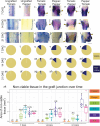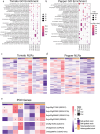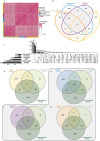Graft incompatibility between pepper and tomato elicits an immune response and triggers localized cell death
- PMID: 39664688
- PMCID: PMC11630344
- DOI: 10.1093/hr/uhae255
Graft incompatibility between pepper and tomato elicits an immune response and triggers localized cell death
Abstract
Graft compatibility is the capacity of two plants to form cohesive vascular connections. Tomato and pepper are incompatible graft partners; however, the underlying cause of graft rejection between these two species remains unknown. We diagnosed graft incompatibility between tomato and diverse pepper varieties based on weakened biophysical stability, decreased growth, and persistent cell death using viability stains. Transcriptomic analysis of the junction was performed using RNA sequencing, and molecular signatures for incompatible graft response were characterized based on meta-transcriptomic comparisons with other biotic processes. We show that tomato is broadly incompatible with diverse pepper cultivars. These incompatible graft partners activate prolonged transcriptional changes that are highly enriched for defense processes. Amongst these processes was broad nucleotide-binding and leucine-rich repeat receptors (NLR) upregulation and genetic signatures indicative of an immune response. Using transcriptomic datasets for a variety of biotic stress treatments, we identified a significant overlap in the genetic profile of incompatible grafting and plant parasitism. In addition, we found over 1000 genes that are uniquely upregulated in incompatible grafts. Based on NLR overactivity, DNA damage, and prolonged cell death, we hypothesize that tomato and pepper graft incompatibility is characterized by an immune response that triggers cell death which interferes with junction formation.
© The Author(s) 2024. Published by Oxford University Press on behalf of Nanjing Agricultural University.
Conflict of interest statement
None to declare.
Figures






Update of
-
Graft incompatibility between pepper and tomato can be attributed to genetic incompatibility between diverged immune systems.bioRxiv [Preprint]. 2024 Apr 1:2024.03.29.587379. doi: 10.1101/2024.03.29.587379. bioRxiv. 2024. Update in: Hortic Res. 2024 Sep 11;11(12):uhae255. doi: 10.1093/hr/uhae255. PMID: 38617251 Free PMC article. Updated. Preprint.
References
-
- Harrison DJ, Burgess PG. Use of rootstock resistance for controlling fusarium wilt of tomatoes. Plant Pathol. 1962;11:23–5
-
- Mudge K, Janick J, Scofield S. et al. . A History of Grafting. In: Hortic Rev. 2009,437–93
-
- Warschefsky EJ, Klein LL, Frank MH. et al. . Rootstocks: diversity, domestication, and impacts on shoot phenotypes. Trends Plant Sci. 2016;21:418–37 - PubMed
-
- Williams B, Ahsan MU, Frank MH. Getting to the root of grafting-induced traits. Curr Opin Plant Biol. 2021;59:101988. - PubMed
-
- Moore R. A model for graft compatibility-incompatibility in higher plants. Am J Bot. 1984;71:752–8 - PubMed
Grants and funding
LinkOut - more resources
Full Text Sources
Molecular Biology Databases

